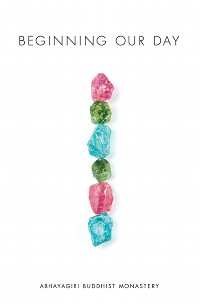The Importance of Informal Meditation
อาจารย์ อมโร

Our teacher Ajahn Chah strongly discouraged us from holding a perception of meditation practice as different and apart from the activities of our ordinary everyday lives. There can be a tendency to think that meditation is what happens when we’re walking up and down the meditation path or in the Dhamma Hall when we have our legs crossed and our eyes closed—that the rest is merely “the other stuff” we need to take care of so we can do “the real thing” of meditation. But Ajahn Chah was very keen to point out that we’re capable of suffering in all modes of our lives, whether we’re sitting on a cushion with our eyes closed, sitting in a classroom, working in the kitchen, driving down the freeway, or chatting with our friends. We can make difficulties for ourselves and experience happiness and unhappiness in every aspect of our lives. So it’s important to bring all those different aspects of our lives into the scope of meditation.
Rather than thinking that meditation equals the activities in the hall or the walking path, it’s more skillful to think in terms of “formal” and “informal” practice. When we sit with our eyes closed and legs crossed, that’s formal practice. When working around the monastery and taking time with each other, this is the same practice, but in an informal mode. The informal practice is sometimes more challenging than sitting on our meditation cushions and trying to be mindful when everything is still, quiet, and highly controlled. So while we go about the various work tasks this morning, we can bring attention and mindfulness to them.
We can notice the different moods we’re feeling. Are they exciting? This is great. This is so wonderful! Or are we thinking, Oh no, another thing for me to fail at? Maybe there’s a feeling of pride. My lines are straighter than anybody else’s. Just look at these lines I painted! The mind that creates problems can be very active. But with practice we’re able to see through whatever state of mind happens to be in play.
We can watch the flow of moods, feelings, and thoughts as they go through the mind. We’re not suppressing them or feeling that we shouldn’t be experiencing these kinds of thoughts or attitudes, but neither are we buying into or being caught up in them. Instead, we’re simply seeing that this is how the mind works. When things go well, we’re happy. When things go badly, we’re unhappy. That’s just the way it is. We are recognizing that this is simply a flow of feeling and perception we’re engaged in, noticing for example the different changes of the day. When we start the work period, it’s nice, cool, and bright. Ah, this is so lovely. What a beautiful place. Then, when the temperature starts to pick up later in the morning, we might think, Oh, it’s really hot. It’s only 10 o’clock, and I’m dying on my feet here. We notice how our attitudes changed with the changing conditions. Oh, how interesting. When it was cool, I felt happy. When it was hot, I felt oppressed. One is a feeling of comfort, the other is a feeling of discomfort. We can see these as nothing more than different impressions and moods that come and go through the mind. We don’t need to make a problem out of them.
By doing this, we’re not negating anything, not thinking we shouldn’t be feeling uncomfortable. We’re merely seeing, When it’s like this I’m happy; when it’s like that then I’m unhappy. We see how fickle the mind can be, how easily we can get caught up in perceptions and moods. We simply bring mindfulness to that. The mind that’s fully attentive to the present moment sees how easily we get caught up, and in that seeing there’s a coolness of heart. There’s an easefulness in the attitude. We find ourselves more easily able to go with the ups and downs of praise and criticism, success and failure, and with all the mundane, ordinary experiences that flow through the day.
Of course, applying this kind of attention and attitude isn’t only for the morning work period, but for the entire course of the day. When the work period finishes, when we gather for the mealtime, after the meal is finished, when the dishes are done, and throughout our open time in the afternoon. We try to keep bringing our attention and the reflective attitude of mind to the flow of mood and perception. This is what’s meant by “mindfulness of everyday life.” It’s as much a part of the meditation as is the formal, quiet sitting—perhaps even more so. The habit is to easily get caught up in the different conversations we’re having or in the work we’re engaged in so that we don’t notice what’s going on inside us. We’re so busy and interested in active and external things. If we first apply a bit of attention to how we’re feeling and attend a bit more closely to our attitude, this will help us find and retain a quality of balance and easefulness. We have the potential to be interested in what we are attending to, but it takes some effort to draw the attention inward.
These are some of the ways we learn to change the lens of our perceptions with regard to formal and informal meditation. Eventually, we may come to understand that meditation is an all-day and sometimes all-night activity. The more we are able to bring mindfulness and attention into every aspect of our lives, the more opportunities there are for wisdom and understanding to arise.
This reflection is from the newly released two part collection of Dhamma Reflections:





